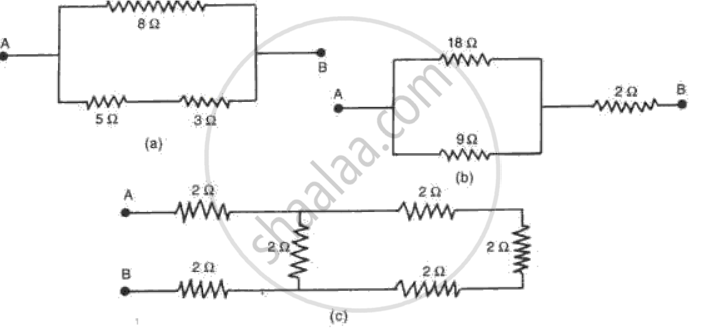Advertisements
Advertisements
Question
What is meant by saying that the potential difference between two points is 1 V?
Solution 1
If 1 J of work is required to move a charge of amount 1 C from one point to another, then it is said that the potential difference between the two points is 1 V.
Solution 2
The potential difference between two points is said to be one volt if one joule of work is done in moving one coulomb of electric charge from one point to the other.
Thus:
1 volt = `(1 "joule")/(1 "coulomb")`
APPEARS IN
RELATED QUESTIONS
Name a device that helps to maintain a potential difference across a conductor.
Define one coulomb charge.
What is a voltmeter?
Name a device which helps to maintain potential difference across a conductor (say, a bulb).
The p.d. across a lamp is 12 V. How many joules of electrical energy are changed into heat and light when:
a charge of 1 C passes through it?
Calculate the power used in the 2 Ω resistor in each of the following circuits: a 6 V battery in series with 1 Ω and 2 Ω resistors.
The following table shows current in Amperes and potential difference in Volts.
Which law will the graph prove? Explain the law.

Three electric cells of potential difference 1.5 V each have been connected as a battery. The potential differences of the battery will be ____________ V.
What is the combined resistance of each of the networks between A and B shown in fig. ?

Five resistors of different resistances are connected together as shown in the figure. A 12 V battery is connected to the arrangement.

Calculate:
(i) the total resistance in the circuit
(ii) the total current flowing in the circuit.
Suppose there are three resistors A, B, and C having resistances r1, r2, and r3 respectively. If R represents their equivalent resistance, establish the following relation `1/"R" = 1/"r"_1 + 1/"r"_2 + 1/"r"_3`, when joined in parallel.
An electric bulb draws 0.5 A current at 3.0 V. Calculate the resistance of the filament of the bulb.
Conceptual question.
A bird sitting on a high power electric line is still safe. How?
State Ohm’s law.
Which of the following represents voltage?
A boy records that 4000 joules of work are required to transfer 10 coulombs of charge between two points of a resistor of 50 Ω. The current passing through it is:
How will you conclude that the same potential difference (voltage) exists across three resistors connected in a parallel arrangement to a battery?
Find out the following in the electric circuit given in Figure
- Effective resistance of two 8 Ω resistors in the combination
- Current flowing through 4 Ω resistor
- Potential difference across 4 Ω resistance
- Power dissipated in 4 Ω resistor
- Difference in ammeter readings, if any.

What is the measure of the work done on the unit positive charge to bring it to that point against all electrical forces?
Twenty-seven drops of same size are charged at 220 V each. They combine to form a bigger drop. Calculate the potential of the bigger drop.
